DEXs, or decentralized exchanges, play a crucial role in the cryptocurrency ecosystem. For the first time in history, they gave traders a way to swap assets without having to go through a centralized authority. They are one of the pillars of decentralized finance (DeFi). For the Avalanche ecosystem’s top DEX AMM floor position, Joe has been working hard. Let’s learn details about this project with Coincu through this Trader Joe Review article.

What is Trader Joe?
Trader Joe is a DEX AMM project on the Avalanche ecosystem. Joe is the folk version of Uniswap.
As a one-stop shop decentralized for finance, Trader Joe bills itself as such, and they most definitely meet the bill. Although it offers capabilities like staking, lending, borrowing, liquidity pools, NFTs, farming, and a launch pad, Trader Joe is a preeminent DEX for trading on Avalanche.
Although he is the younger brother behind Pangolin, the top position in the DEX segment is held by Trader Joe. This is understandable because Joe is providing featured features that help retain users.
Pseudonymous creators 0xMurloc and Cryptofish established Trader Joe in 2021 with the goal of developing the future of decentralized finance by building a distinctive and cutting-edge trading platform on the Avalanche blockchain.
According to Cryptofish, a full-stack and smart contract engineer with a master’s in computer science, he has worked at Google and was an early contributor to various Avalanche projects, including Snowball and Sherpa Cash. Full-stack developer 0xMurloc works for Grab as a Senior Product Lead and has experience working for various businesses. As the creators are essentially unidentified, we must take their statements at face value.
The platform has drawn nearly $4 billion in total value locked (TVL) since its introduction, making it the biggest DEX on Avalanche very rapidly. This is a picture of the investors who believe in the platform, who are also supporting Trader Joe with significant sums of money and industry heavyweights:

Project information
Source
Trader Joe was born from the desire to be able to combine DEX floor with many features, creating a typical and advanced trading platform. Resonance with the advantages of the Avalanche blockchain network, Trader Joe responds to all objects around the globe, developing DEFI to a new level.
Brand value
Traders Joe aims to include:
- Community approach
- Improve, speed and safety
- Defi background is easy to access for all
In addition, there is the core value of the brand, including:
- Providing DEFI platform with a “one for all” experience
- Quickly adapt, build a project quickly, not compromise with a “safe area”
- Improving, innovating DEFI, developing through all limits.
Future vision
The ultimate goal of Trader Joe will always be a platform in which users can experience all DEFI activities with high speed, advanced technology, and, above all, safety. Now, the Trader Joe Review article will explore the project’s products.
Trader Joe’s Products
DEX
This is where users can swap tokens. Just select the 2 tokens you want to trade and click. A special feature of Joe is that the floor provides you with a chart for reference, you can find a reasonable entry/exit point. Quite an interesting feature, isn’t it?
The liquidity of the pairs will be provided by the Liquidity Providers who stake in the pool.
When users perform swap, there will be 0.3% transaction fee charged, of which 0.25% will be paid for Lps, the rest will be sent to Joe token farm.
Yield Farming
One way to help you increase your wealth is farming, you can deposit Lp tokens into pools to earn JOE according to the farming rate.
Especially in Joe, your token will not be locked or lost time when withdrawing to the wallet. Pretty good point, isn’t it?
Staking
The auto-compounders function can help you to increase your lp tokens by automatically selling JOE from farming. For example, if you are farming the AVAX-USDT pair, the auto-compounder will give you a lot of AVAX but no more JOE tokens. Moreover, you can also suffer temporary loss when farming.
Instead, to be on the safe side. Staking is the solution. You can accumulate more xJOE, risk almost no and can also withdraw at any time.
Mechanism of action
xJoe is the main staking mechanism on Trader Joe. By staking, you are converting JOE to xJOE. After a while, you will earn more JOE.
To account for this, when each trade is made on Trader Joe. There is a 0.05% fee transferred to Pool xJoe. This amount will be used to buy back JOE every 2 days. And then when you swap xJOE to JOE again, you’ve got some more JOE tokens.
Lending
Lending Banker Joe platform has just launched this October. Based on the Compound Protocol platform, we have shown the power of a dex exchange when integrated with lending.
Tokenomics
JOE is the governance token of Trader Joe, this is also the token used to reward Defi activities on the platform.
Token metrics
- Token name: Trader Joe
- Token Ticker: JOE
- Blockchain: Avalanche
- Token Standard: ARC-20
- Contract: 0x6e84a6216eA6dACC71eE8E6b0a5B7322EEbC0fDd
- Token Type: Utility, Governance
- Total Supply: 500,000,000
- Circulating Supply: 108,428.88
Distribution
- Liquidity Provider: 50%
- Treasury: 20%
- Dev Team: 20%
- Future Investor: 10%
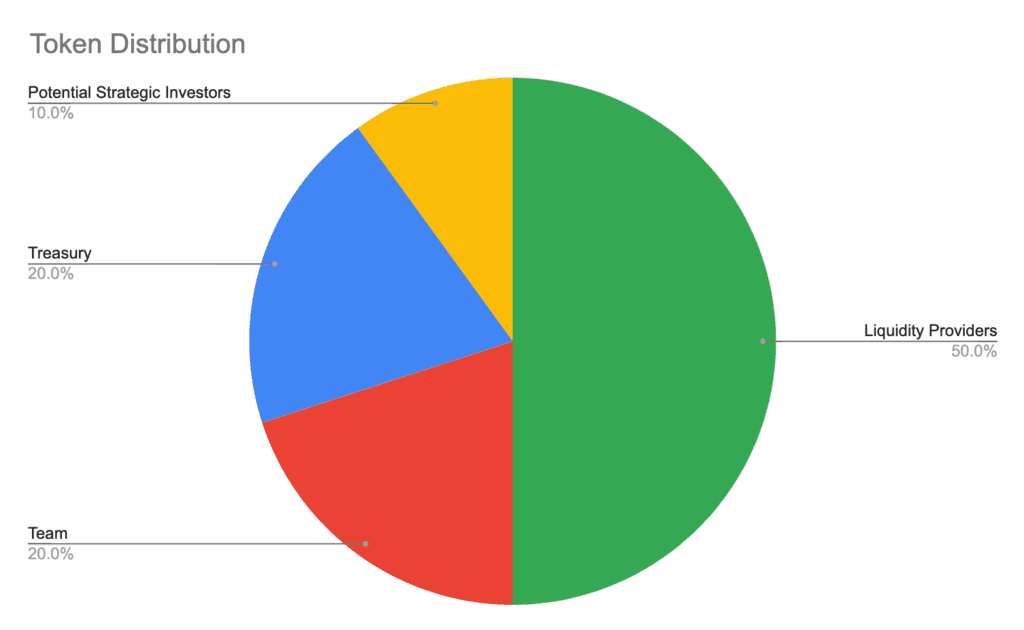

Token Emissions
There is no pre-sale, no private sale
Therefore tokens will be distributed according to the schedule. Ensure that tokens are distributed at the same rate between funds and LP farm.
Token Usecases
Management
In the long term, Joe intends to become a community-governed project such as a DAO by using the $JOE token to participate in voting.
Proposals
Community suggestions will be posted to the forum, where all members can discuss to clarify the issue.
When those proposals are good enough, the core team will also participate in the voting. More specific information will be available when the voting function is launched.
Voting
Voting will take place at this address by counting JOEVOTE. Detail:
Every $JOE in pool $JOE-$AVAX = 2 JOEVOTE
Each JOE or xJOE hold = 1 JOEVOTE
Features
Trading
This will appear familiar to anyone who has used a typical AMM DEX like Uniswap because Trader Joe operates according to the same principles. Simply click the Trade button at the top of the screen, or click the Trade tokens tile as follows:
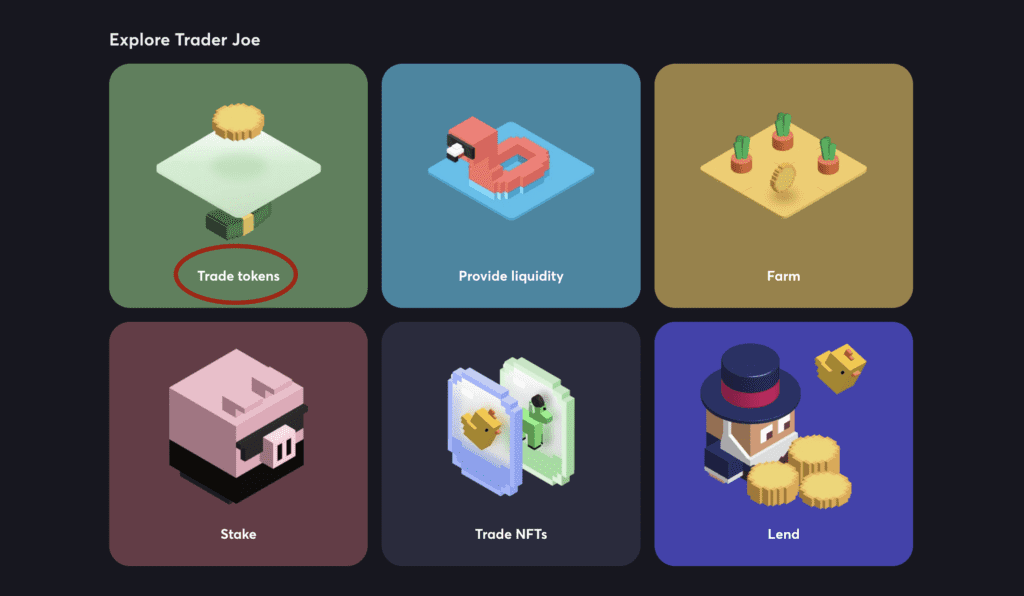
This will take you to the simple trading page where you may exchange tokens. By doing this, you will be able to trade any tokens that are currently in your MetaMask for fresh tokens. A confirmation box will appear before you click the Swap button, providing you with some crucial information about your swap, which looks like this:
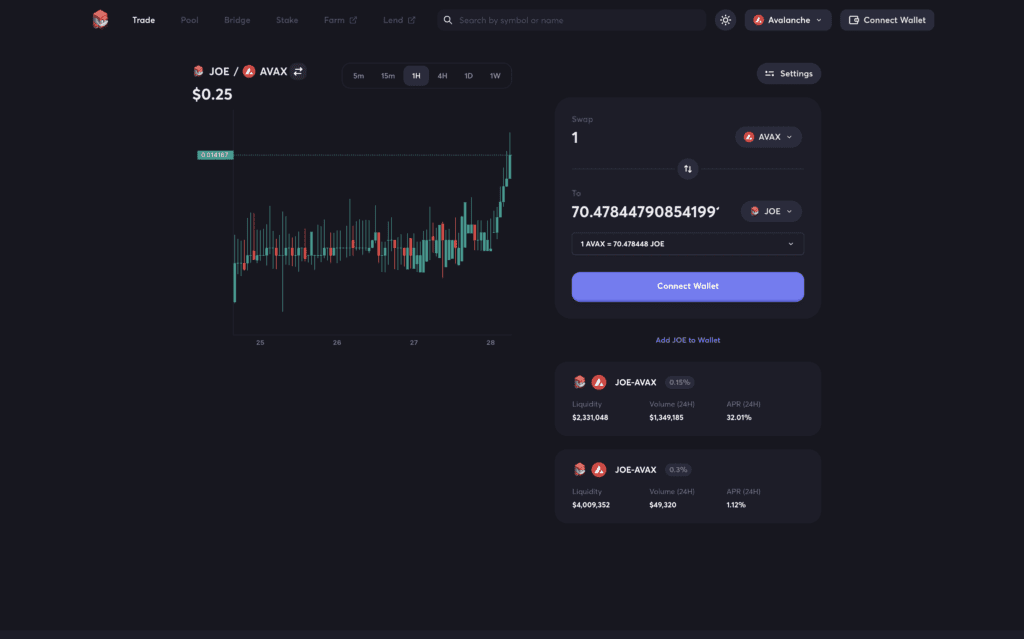
Minimum received – You will receive is shown above, and it accounts for factors like potential slippage. If there is a sharply negative price change before the transaction is verified, the transaction will immediately reverse.
Price Impact – This displays how your swap will affect the liquidity pools in terms of price. Whales don’t want to have a significant negative influence on the pool, therefore this only has to be taken into account if you are trading in huge sums.
Liquidity Provider Fee – This charge compensates liquidity providers for their contributions to the DEX’s liquidity needs. Without these individuals, many of whom are regular people like you and me who choose to only offer liquidity, a DEX could not function.
A popup will appear when you click the Switch button asking you to confirm the transaction. After you click Confirm Swap, your MetaMask wallet will open and request your signature or confirmation of the transaction. MetaMask just approves the transaction from the wallet side, which is standard practice.
Liquidity Pools
Users may add their tokens to Trader Joe’s liquidity pools, just as with other DEXs, and gain some passive revenue from the platform’s fees.
You will be sent to a page that lists all the token pair pools that are available for you to join and provide liquidity for, along with all the token pools you are currently a member of when you click into the pool area. You also have the option to build a pool.
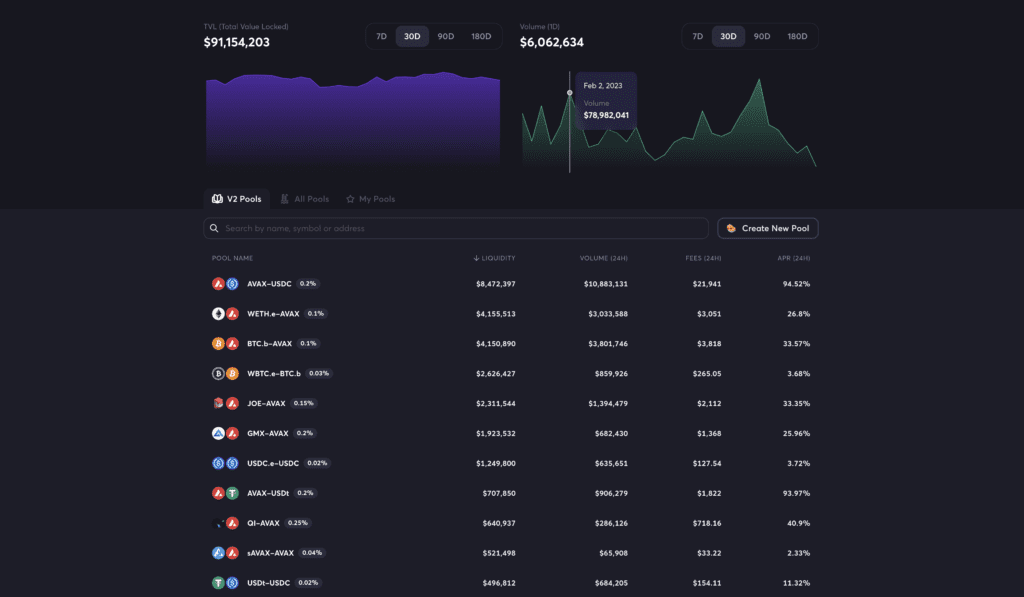
Yield Farming
If you’re going to be supplying liquidity on Trader Joe, you might as well use Yield Farming as well, making a wonderful one-two passive income punch.
Users can be encouraged to increase liquidity by using farms. All of the token pairings you may add tokens to are displayed in the farm area, along with the best farms, stablecoin farms, and any farms:
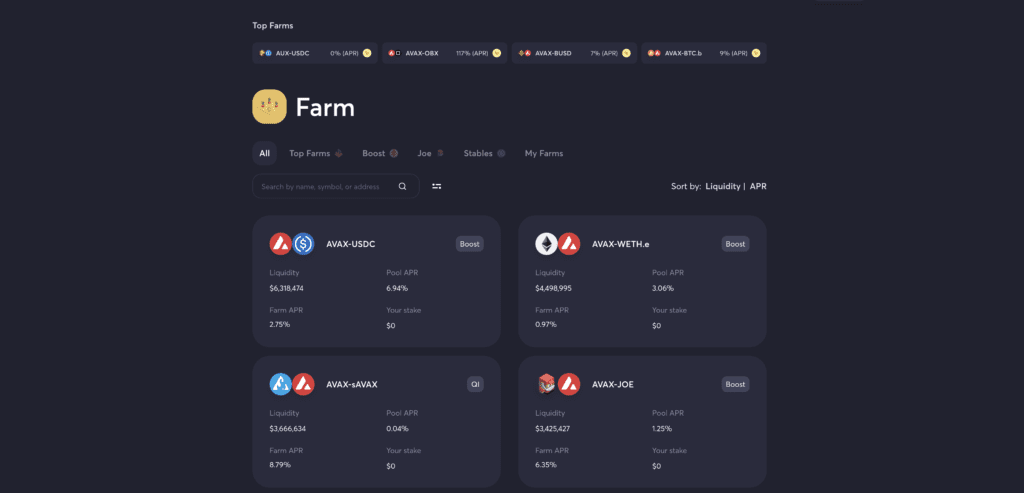
Staking
Joe also allows staking, which is a good bonus and improves the platform’s usefulness.
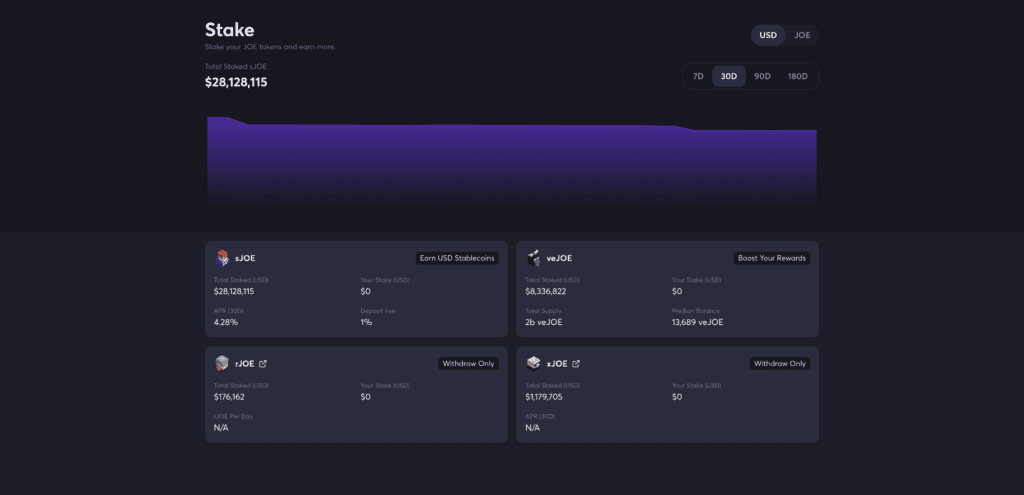
Lending (Banker Joe)
While farming and liquidity pools can be intimidating, Trader Joe Lend offers a far more user-friendly and straightforward approach to generating passive income on your assets.
You may lend tokens to other users and make money if you have some laying around in your MetaMask wallet. As you enter the Lend section, you will see the deposit able tokens and the APY:
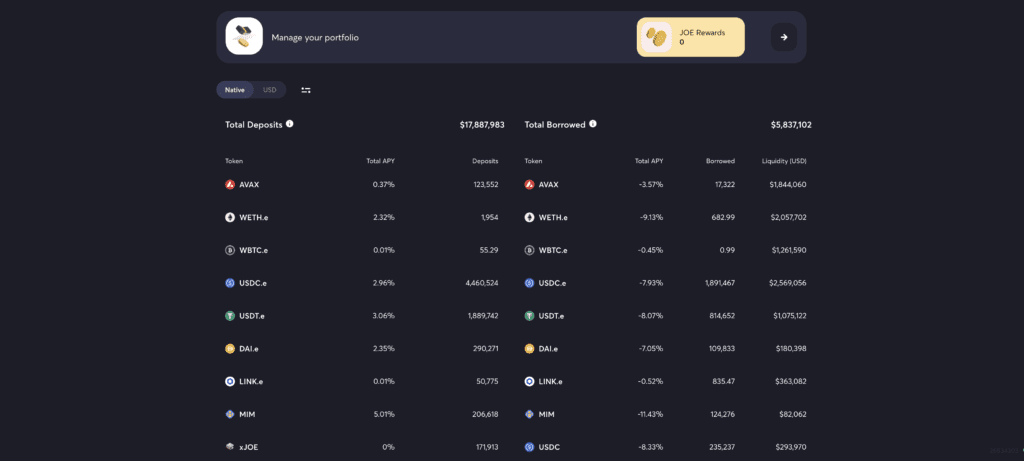
Trader Joe NFTs
Moreover, Joe provides Joepegs, an NFT marketplace where customers may advertise and purchase AVAX NFTs. While Solana and Ethereum probably support the most NFTs, other networks like Cardano and Avalanche are fast gaining popularity as blockchains that enable NFTs.

Fees
As with any reliable DeFi DEX, the costs are negligible in comparison to those charged by centralized exchanges. Like any top-tier DEX, the majority, if not all, of the fees should be returned to the community and LPs who enable the DEX. There is no nefarious business going on here; Trader Joe is legitimate and on the up and up.
Users will pay substantially less in transaction costs on the DEX because it is based on AVAX than on its Ethereum equivalents; on average, fees range from 1 to 5 cents, and all of these payments go to the Avalanche network validators rather than the Trader Joe platform.
On the platform, there will be a 0.3% trading charge for token swaps.
0.25 percent – A trading charge for liquidity providers paid to liquidity pools.
0.05% – Sent to sJOE Staking
Customer Support
On Trader Joe official Discord help desk, assistance is available. As a general rule, I never anticipate receiving good help from DeFi because the majority of these platforms are not managed by paid employees. These are forums designed by and for the people.
These platforms typically have a large community, and assistance is frequently obtained thanks to the kindness of the people who use sites like Reddit and Discord to support one another. With over 15k members, the Trader Joe Discord is one of the better support conversations I have used, so getting help here is really quick and simple.
A very well-written whitepaper from Trader Joe also outlines all consumers need to know and includes tutorials to aid with many questions.
Conclusion of Trader Joe Review
Trader Joe is gradually achieving his goal: To be a dex floor with all the features. Joe is outperforming his elder brother Pangolin in the DEX segment. Not only stopping on the Avalanche ecosystem, Trader Joe also makes other competitors wary.
Banker Joe’s run caused Joe’s TVL to spike. Shows the core team’s vision is very good. We wouldn’t be shocked to see the platform continuing to expand, be used, and be successful given that Trader Joe is firmly holding the status of top DEX on AVAX. Hopefully the Trader Joe Review article has helped you understand more about the project.
DISCLAIMER: The Information on this website is provided as general market commentary and does not constitute investment advice. We encourage you to do your own research before investing.
Join us to keep track of news: https://linktr.ee/coincu
Harold
Coincu News














